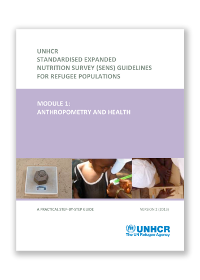OBJECTIVES
The objectives of Module 1 are as follows:
Primary objectives
- To measure the prevalence of acute malnutrition in children aged 6-59 months.
- To measure the prevalence of stunting in children aged 6-59 months.
- To determine the coverage of measles vaccination among children aged 9-59 months (or context-specific target group e.g. 9-23 months).
- To determine the coverage of vitamin A supplementation in the last six months among children aged 6-59 months.
- To determine the two-week period prevalence of diarrhoea among children aged 6-59 months.
Secondary objective
- To determine the coverage of targeted supplementary and therapeutic feeding programme in children 6-59 months.
The standard target group to routinely include in an anthropometric assessment in refugee contexts is children aged 6-59 months. When justified, other age groups are sometimes also included.
All children aged 6-59 months will be assessed for measles vaccination although data will only be analysed for the 9-59 months age group (or other context-specific target group e.g. 9-23 months).
All children aged 6-59 months will be assessed for vitamin A supplementation in the last six months and diarrhoea in the last two weeks.
KEY MESSAGES
- Data on the prevalence of acute malnutrition (based on weight-for-height and / or oedema) and stunting (based on height-for-age) among children aged 6-59 months is essential to collect in refugee settings for monitoring purposes. When justified, other age groups are sometimes also included.
- Data on the coverage of measles vaccination, the coverage of vitamin A supplementation in the last six months and the two-week period prevalence of diarrhoea in young children is essential to collect in refugee settings for monitoring purposes.
- The standard questionnaire provided in Module 1 should be used for the collection of anthropometric, measles vaccination, vitamin A supplementation and diarrhoea data.
- Providing good quality training to survey teams, supervising them well and checking the quality of the data they are collecting on a daily basis will help ensure that data are reliable.
- Standard methods have been developed for collecting, analysing and presenting anthropometric data in reports. Standardising this process helps to maintain the quality, reliability and usability of nutrition survey data.
- The prevalence of stunting (height-for-age) and underweight (weight-for-age) should be presented as part of the survey report but should be interpreted with caution where reliable age data is not available (as is the case in many refugee situations).
- There are standard ways of reporting anthropometric, measles vaccination, vitamin A supplementation and diarrhoea results that should be followed in all nutrition survey reports produced in refugee contexts.
CAUTION!
- There will be therapeutic and supplementary feeding programmes in most refugee settings to take care of acutely malnourished children. A nutrition survey is a good opportunity to ask about enrolment of the surveyed children into the feeding programmes running in the area for the treatment of acute malnutrition. This will only provide a rough estimation of the coverage of such programmes but may point out to some major problems that can be addressed following the survey. However coverage surveys as opposed to nutrition surveys are the best way to determine the coverage of these types of feeding programmes due to the small sample size of acutely malnourished children found during nutrition surveys. This is why this objective should always be worded as a secondary objective.
- The systematic inclusion of infants aged 0-5 months in anthropometric survey is not currently recommended by UNHCR for the following main reasons: (1) The accurate weight measurement of infants 0-5 months requires an infant scale with a higher precision (+/-10g) than those most commonly used on the field (+/- 100g); (2) If a meaningful, precise estimate of infant malnutrition is needed for programmatic purposes, sample size requirements can be difficult to meet; (3) Interpretation of malnutrition results among children aged 6-59 months and 0-59 months are often wrongly used interchangeably and compared; and (4) Reporting malnutrition results among children aged 6-59 months is currently the norm in refugee settings and emergencies. However, in certain circumstances, where there may be particular concerns over the nutritional status of infants 0 – 5 months old, these infants may also be included in the anthropometric assessment if proper scales are used, specialised training is provided for measuring infants’ length (e.g. a cloth needs to be used below the knees of infants during length measurement) and sample size requirements are met. Note that prevalence of severe acute malnutrition calculated using the WHO Growth Standards (2006) will be much higher than when using NCHS Growth Reference (1977) in infants aged 0-5 months.
Downloads
SENS Module 1 – Anthropometry and Health ![]()
![]()
Tool 1 – Local Events Calendar ![]()
![]()
Tool 2 – Anthropometry Quality Assurance Logsheet ![]()
![]()

